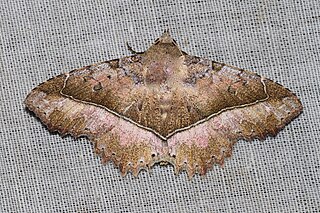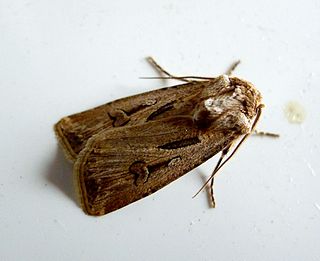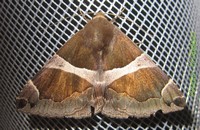
The flame shoulder is a moth of the family Noctuidae. The species was first described by Carl Linnaeus in 1761. It is distributed throughout the Palearctic from Ireland in the west to Siberia then Korea and Japan in the east.

Grammodes geometrica is a moth found from the Mediterranean east to Oriental and Australasian tropics of India, Sri Lanka, Java and Australia. The adult is a fruit piercer. The species was first described by Johan Christian Fabricius in 1775.

Tamba is a genus of moths in the family Erebidae. It was erected by Francis Walker in 1869.

Agrotis spinifera, or Gregson's dart, is a species of moth in the family Noctuidae. The species was first described by Jacob Hübner in 1808 and is found in southern Europe, Arabia to southern Africa, Madagascar, Turkey, Iraq, Iran, Afghanistan, Pakistan, India to Myanmar and Sri Lanka.

Dysgonia torrida, commonly known as the jigsaw, is a species of moth in the family Erebidae. The species was first described by Achille Guenée in 1852. It is found from the tropical and subtropical areas of Africa to Spain, southern Italy, Greece, Syria, Israel, Iran, Uzbekistan towards India, Sri Lanka and Myanmar.

Leucania loreyi, the cosmopolitan, false army worm or nightfeeding rice armyworm, is a moth of the family Noctuidae. It is found in most of African countries, the Indo-Australian subtropics and tropics of India, Sri Lanka, Myanmar, the eastern Palearctic realm, and the Near East and Middle East. The species was first described by Philogène Auguste Joseph Duponchel in 1827.

Ctenoplusia albostriata, the eastern streaked plusia, is a moth of the family Noctuidae. It is found in India, Sri Lanka, eastern Asia and the Pacific, including Borneo, Hong Kong, Vietnam, Japan, most of Australia and New Zealand.
Trichoplusia lectula is a moth of the family Noctuidae first described by Francis Walker in 1858. It is found throughout Asia, including the Indian subregion, Sri Lanka, Thailand, Borneo, Java, Japan, as well as Western Australia and Queensland.

Oraesia emarginata is a species of moth of the family Erebidae first described by Johan Christian Fabricius in 1794. It is found in Australia, New Caledonia, Indonesia, New Guinea, Pakistan, the Philippines, India, Sri Lanka, Sulawesi, Taiwan, China, Japan, Korea and Nepal as well as Eritrea, Ethiopia, Kenya, Namibia, Nigeria, South Africa, Tanzania, the Gambia, Uganda, Oman and Yemen.

Tirathaba rufivena, the coconut spike moth, greater coconut spike moth or oil palm bunch moth, is a moth of the family Pyralidae. It is found from south-east Asia to the Pacific islands, including Malaysia, the Cook Islands, the Philippines and the tropical region of Queensland, Australia. They are considered as a minor pest.
Agdistopis sinhala is a moth of the family Macropiratidae. It is found in south-east Asia, including Sri Lanka, India, Japan and Taiwan.

Actinotia intermediata is a species of moth of the family Noctuidae. It is found in Asia, including India, Sri Lanka and Taiwan.
Schrankia croceipicta is a species of moth of the family Erebidae. It was first described by George Hampson in 1893. It is found in Sri Lanka and the Seychelles.
Nyctemera latistriga is a moth of the family Erebidae first described by Francis Walker in 1854. It is found from the Oriental tropics of India, Sri Lanka, Myanmar, Andaman Islands, Sumatra, Borneo to the Philippines and Lombok.
Gunda thwaitesii is a species of moth in the family Bombycidae. It was described by Frederic Moore in 1883 and is found in Sri Lanka.
Oraesia provocans, the provocative calpe, is a moth of the family Erebidae. The species was first described by Francis Walker in 1858. It is found throughout continental Africa, India and Sri Lanka.
Sthenistis is a monotypic moth genus in the family Immidae. Its only species, Sthenistis gyrtoniformis, is found in Sri Lanka. Both the genus and species were described by George Hampson in 1896.
Holocryptis erubescens is a moth of the family Noctuidae first described by George Hampson in 1893. It is found in Sri Lanka, Thailand and Japan.
Pterogonia nubes is a moth of the family Nolidae first described by George Hampson in 1893. It is found in Sri Lanka, Peninsular Malaysia, Sumatra, Borneo, the Philippines and Sulawesi.










